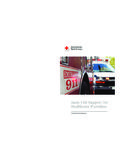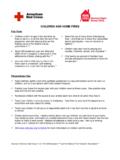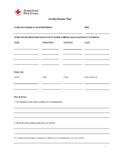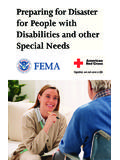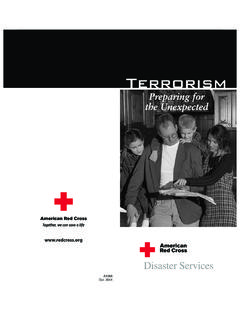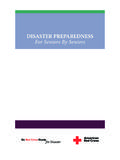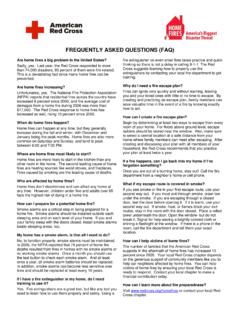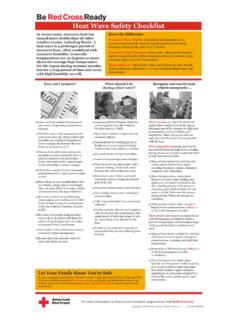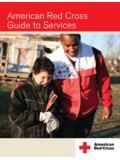Transcription of Safety Training for Swim Coaches - American Red Cross
1 Safety Training for Swim CoachesSUPPLEMENTA merican Red Cross Safety Training for Swim CoachesCopyright 2008 by The American National Red CrossiiAcknowledgmentsACKNOWLEDGMENTSThe Safety Training for Swim Coaches Supplementwas developed through the dedication of both employees and volunteers. Their commitment to excellence made this supplement following American NationalRed Cross and USA Swimming staffcontributed to the development ofthis supplement:Sue AndersonResource Development SpecialistUSA SwimmingTom AvischiousProgram and Services DirectorUSA SwimmingCharlene BoudreauPerformance Services ManagementDirectorUSA SwimmingMike EspinoProject Manager, Aquatics TechnicalDevelopmentAmerican Red CrossResearch and Product DevelopmentConnie HarveyManagerAmerican Red CrossResearch and Product DevelopmentMick NelsonClub Facilities Development DirectorUSA SwimmingLindsay Oaksmith, CHESS enior Associate, Aquatics TechnicalDevelopmentAmerican Red CrossResearch and Product DevelopmentDave ThomasSport Development ConsultantUSA SwimmingThe following individuals also pro-vided guidance, support or review.
2 matthew BarnettHolme Roberts & Owen LLPG eorge BlockTechnical Vice PresidentUSA SwimmingTom DolanOlympic Gold Medalist 1996, 2000 Barney FavaroFormer General CounselUSA SwimmingJohn LeonardExecutive DirectorAmerican Swimming CoachesAssociationAllan MeierHPER InstructorWestern Oklahoma State CollegeJohn PetersonPresident/CEORisk Management Services, StephensHead CoachNorth Baltimore Aquatic ClubRichard YoungHolme Roberts & Owen LLPThe StayWell team for this editionincluded Shannon BatesManaging EditorBryan ElrodSenior Developmental EditorStephanie WeidelSenior Production EditorPhotos on pages 2, 3, 9 (Fig. 2-2) and17 (Fig. 2-10) are courtesy of USAS wimmingTable of ContentsiiiIntroduction ..ivChapter 1 Responsible Coaching ..1 Guidelines for Responsible Coaching ..2 Professional Conduct and Legal Responsibilities ..4 Sexual Misconduct and Abuse ..4 Chapter 2 Safety Awareness in Competitive Swimming.
3 7 Training Plans and Athlete Fitness ..8 Swim Practice Safety ..8 Important Safety Considerations ..9 Organizing Your Swim Practice ..10 Hypoxic Training and Hyperventilation ..11 Turns ..11 Head-First Entries and Racing Start Safety ..12 Dryland Training ..14 Event Safety ..15 Open Water Swimming Safety ..17 Chapter 3 Emergency Planning and Response ..21 Water and Air Quality ..22 Pool Chemicals ..23 Electrical Safety ..23 Weather and Environmental Conditions ..23 Other Facility Safety Issues and Recommendations ..25 Minimizing Risk ..25 Emergency Planning ..26 Distressed Swimmer and Drowning Situations ..27 How the Coach Can Assist ..28 Chapter 4 Common Injuries and Medical Conditions ..29 Head, Neck and Back Injury ..30 Hypothermia ..30 Heat-Related Emergencies ..30 Medical Conditions in Swimmers ..31 Common Swimming-Related Injuries ..34 Glossary .. 37 References .. 39 TABLE OF CONTENTSINTRODUCTIONThis supplement along with the American Red Cross Swimming and Water Safetymanual is re-quired material for the American Red Cross Safety Training for Swim Coaches course.
4 Successfulcompletion of the Safety Training for Swim Coaches course meets the water Safety requirementof the USA Swimming Coaches Safety information in this supplement centers on possible life-threatening or hazardous situations inand around the water and the techniques and skills for preventing and dealing with information on athlete development, Training and workout design, visit the USA Swimmingand the American Swimming Coaches Association (ASCA) Web sites. Both of these organizationsprovide extensive educational resources and materials for supplement includes workout and warm-up procedures, racing starts, event Safety , emer-gency planning, electrical Safety , weather and environmental conditions and handling of medicalconditions and injuries. The material presented in this supplement may be adapted to meet the individual needs of each aquatic facility or swim club. Throughout this supplement there are Internet hyperlinks to publications, resources and sample forms for use by swim Coaches .
5 Whenviewing this supplement online, click on the hyperlink to access the , terms common to swimming are used throughout. The terms or phrases that may be unfa-miliar to new Coaches are set in bold face type and are underlined. When viewing this supple-ment online, scroll over the term or phrase to display the definition. These terms are also definedin the 1 Responsible CoachingGUIDELINES FOR RESPONSIBLECOACHING Coach Brown feels that she is a good judge of talent. Recently Jennifer, a 9-year-old swimmer, joined her pro-gram. Coach Brown was very excited to start coachingJennifer. After only a few weeks of practice, CoachBrown moved Jennifer into a Training group composedmainly of 12 to 14 year olds who practice six days aweek. Jennifer did not seem very happy to leave herfriends and told her parents that swimming with the olderkids was not fun. Coach Brown continued to push Jennifer very hard and was very critical of any poor per-formances, demanding only the best from Jennifer.
6 In ayear, Coach Brown began to enter 10-year-old Jennifer in Seniorevents. Now Jennifer is no longer winning all ofthe events she swims and often cries a lot after herraces. She has developed shoulder and back pain andcan barely complete a workout. After a few months, Jennifer s parents tell Coach Brown that they are takingJennifer to a different club. Coach Brown is stunned andhurt. Has Coach Brown been a responsible coach forJennifer?In the scenario above, Coach Brown was so excitedabout Jennifer s talent that she apparently lost sight ofthe fact that Jennifer was only 9 years old and juststarting out in swimming. She had Jennifer trainingwith much older swimmers and was critical and de-manding. Jennifer s physical ailments may have beencaused or aggravated by the rapid increase in trainingload. Responsible coaching is a major factor in preventinginjuries and providing a safe, enjoyable environment (Fig.)
7 1-1). To provide a safe and enjoyable environment,you should follow these general what motivates athletes, particularly chil-dren, to play their sport. Their goal is seldom to win orexcel. Young athletes give the following as their pri-mary reasons for being involved in athletics: Have fun and enjoy the excitement of competition Improve skills, face challenges and learn new skills Get exercise and stay in shape Enjoy teamwork (Fig. 1-2) the rules of the sport and insist that athletesalso know and follow them. Teach athletes to play Training and competition within the the basics of skill development and train-ing methods appropriate for the level of the and stay informed about coaching based on theprinciples of growth and development. USA Swim-ming s Successful Sport Parenting CD-ROM has ex-tensive material on athlete growth and development. the Safety guidelines of USA Swimming and itsLocal Swimming Committees (LSCs)or other nationalgoverning body, facility and individual sportsmanship by example.
8 Make sure swim-mers feel good about doing their best, regardless ofwinning or losing. Never ridicule or shout at athletesfor making mistakes or constructive criticism with support and praise(Fig. 1-3).2 American Red Cross Safety Training for Swim CoachesFig. 1-1 Fig. 1-2 Fig. that equipment and the facility are athletes about the dangers of nutritional andsubstance exactly do these guidelines mean for a swimcoach in practical terms? Obviously there is more in-volved than designing swim sets and teaching strokework. Here are some of the things you must keep in mindon a day-to-day for swimmers long-term skills development. Allinstruction should be tailored to the needs, skills andabilities of the swimmers. and supervise (Fig. 1-4). Ensure that swimmersare supervised by certified Coaches including your-self and other assisting the aquatic facility. Regularly check theswimming facility and equipment for deficiency orneed of repairs, document the findings in writingand report them to the facility management (seethe Sample Facility Safety Checklist in the USAS wimming Safety /Loss Control Manual).
9 Keep acopy of the report. Advise USA Swimming, or theapplicable national governing body, of any itemsreported to the facility that have not been cor-rected within a reasonable time of inherent risks. Notify swimmers and the par-ents of minors of risk factors, such as possible injuryin the sport. Swimmers can get injured! aware of swimmers medical conditions. Suggestpreseason medical examinations. Establish a proce-dure to be made aware of any preexisting or acutemedical conditions. A Medical History Questionnaireis Training and competitive opportunities. En-sure fair practice and swim meet experiences thatrelate to each athlete s ability and and understand emergency procedures. Beaware of the facility s emergency action plans(EAPs)and be knowledgeable about appropriate firstaid and emergency response procedures. Coachesmust also know their roles in any a Safety role model. Swimmers will adopt andmodel safe Coaching3 Common Accident AreasAccording to USA Swimming accident reportstatistics, the most common areas where acci-dents occur during practice or meets are In the water (over 40 percent) where swim-mers may injure themselves during turns orfinishes, collisions with other swimmers orwhen entering or leaving the water.
10 On the pool deck (over 20 percent) whereswimmers may slip on the deck surface ortrip over pool or Training equipment. Other areas within the aquatic facility, suchas locker rooms, bleachers or accidents may be minimized or elimi-nated by the Safety -trained swim coach who isalert and aware of potential hazards in andaround practice and swim meet areas. TheSafety Training for Swim Coaches Supplementprovides information for the swim coach to usein conducting an enjoyable, competitive andsafe swimming able to say no. Coaches are sometimes so mo-tivated to see kids move, play and have fun that theyneglect potential Safety procedures and rules. Review fre-quently with the CONDUCT AND LEGALRESPONSIBILITIESC oach Smith works several jobs. He sometimes arrives atthe pool after his athletes are already there. He oftenfinds them playing around on the pool deck. Although hehas told them not to get in the water until he gets there,on hot days they are sometimes in the pool.
